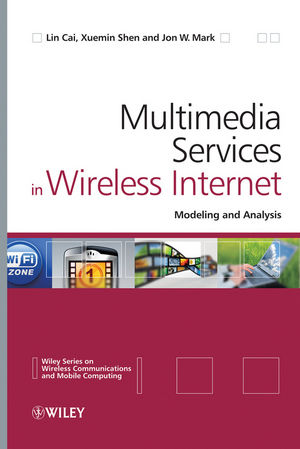|
Textbook
Multimedia Services in Wireless Internet: Modeling and AnalysisISBN: 978-0-470-77065-8
Hardcover
290 pages
July 2009, ©2009
 |
||||||
About the Authors.
Preface.
1 Introduction.
1.1 Convergence of Wireless Systems and the Internet.
1.2 Main Challenges in Supporting Multimedia Services.
1.3 Organization of the Text.
2 Packet-level Wireless Channel Model.
2.1 Introduction.
2.2 Finite-state Markov Model for Fast Fading Channels.
2.3 Channel Model for Frequency-selective Fading Wireless Channels.
2.4 Channel Model for Indoor UWB Wireless Channels with Shadowing.
2.5 Summary.
2.6 Problems.
3 Multimedia Traffic Model.
3.1 Modeling VoIP Traffic.
3.2 Modeling Video Traffic.
3.3 Performance Study of Video over Wired and Wireless Links.
3.4 Scalable Source Coding.
3.5 Summary.
3.6 Problems.
4 AIMD Congestion Control.
4.1 Introduction.
4.2 AIMD Protocol Overview.
4.3 TCP-friendly AIMD Parameters.
4.4 Properties of AIMD.
4.5 Case Study: Multimedia Playback Applications with Service Differentiation.
4.6 Performance Evaluation.
4.7 Summary.
4.8 Problems.
5 Stability Property and Performance Bounds of the Internet.
5.1 A Fluid-flow Model of the AIMD/RED System.
5.2 Stability and Fairness Analysis with Delay-free Marking.
5.3 Boundedness of the Homogeneous-flow AIMD/RED System with Time Delay.
5.4 Summary.
5.5 Problems.
6 AIMD in Wireless Internet.
6.1 Introduction.
6.2 Related Work.
6.3 System Model.
6.4 Analytical Model for Window-controlled Flows.
6.5 Parameter Selection for AIMD.
6.6 Performance Evaluation.
6.7 Summary.
6.8 Problems.
7 TCP-friendly Rate Control in Wireless Internet.
7.1 Introduction.
7.2 System Model.
7.3 Analytical Model for Rate-controlled Flows.
7.4 Performance Evaluation.
7.5 Summary.
7.6 Problems.
8 Multimedia Services in Wireless Random Access Networks.
8.1 Brief History of Random Access Technologies.
8.2 IEEE 802.11 Protocol.
8.3 WLAN with Saturated Stations.
8.4 WLAN with Unbalanced Traffic.
8.5 TFRC in the Mobile Hotspot.
8.6 Summary.
8.7 Problems.
Appendices.
Appendix A TCP and AQM Overview.
A.1 TCP Protocol.
A.1.1 TCP connection management.
A.1.2 TCP error control.
A.1.3 TCP flow control and congestion control.
A.2 Active Queue Management.
Appendix B Datagram Congestion Control Protocol Overview.
B.1 DCCP-2: TCP-like Congestion Control.
B.2 DCCP-3: TFRC Congestion Control.
References.
Index.



